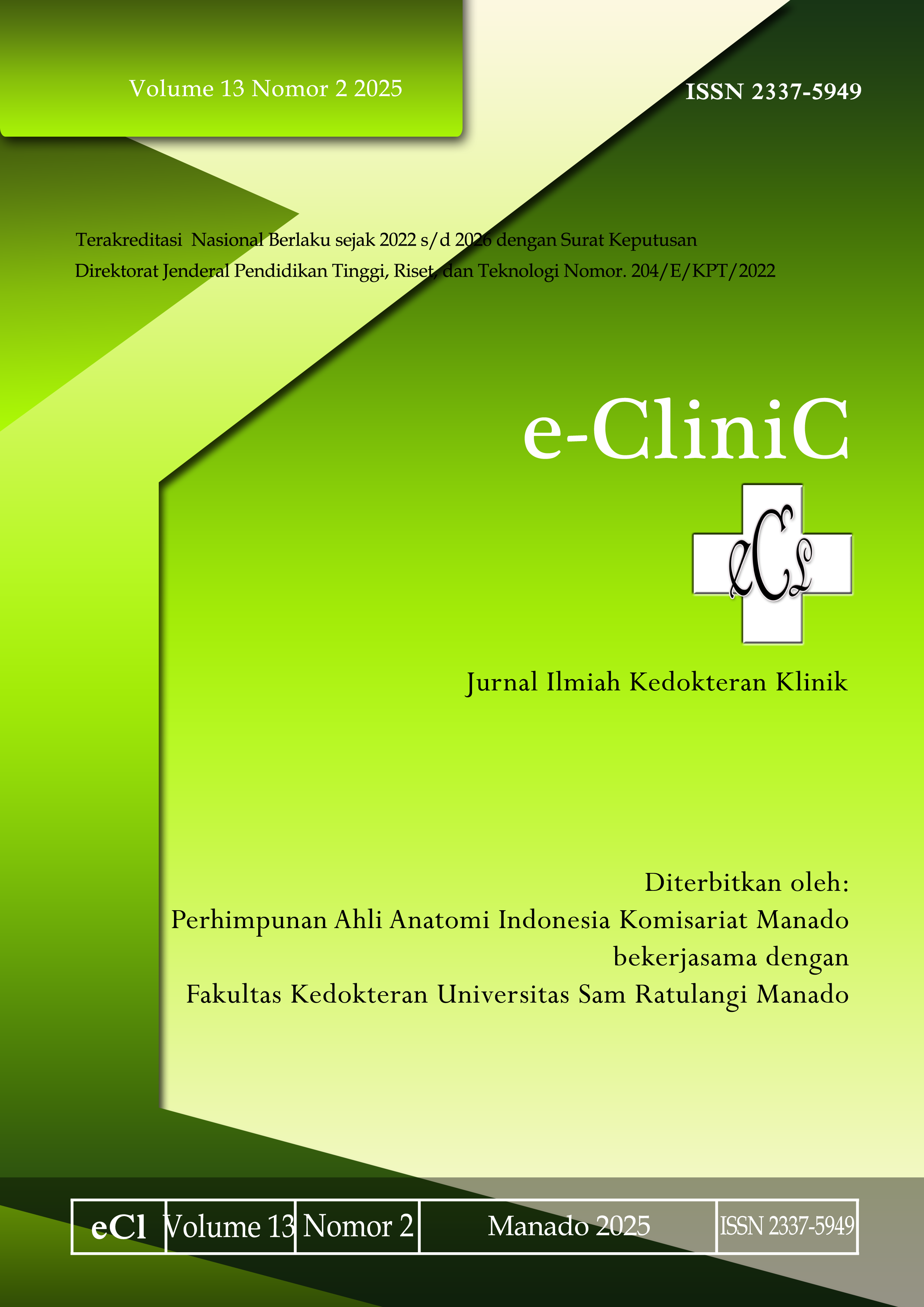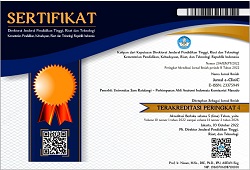Gambaran Kadar Profil Lipid pada Stroke Iskemik
DOI:
https://doi.org/10.35790/ecl.v13i2.60738Abstract
Abstract: Stroke is one of the leading causes of death and disability worldwide. Dyslipidemia is one of the risk factors for stroke that can trigger atherosclerosis in blood vessels in the heart as well as in the brain. This study aimed to obtain the lipid profile in patients with ischemic stroke at Prof. Dr. R. D. Kandou Hospital. This was a descriptive and retrospective study using medical records of patients ischemic stroke patients at Prof. Dr. R. D. Kandou Hospital in 2022, using the total sampling method. The results obtained 78 patients that met the inclusion criteria. The highest percentages were found in male patients (56.4%), age group of 56–65 years (42.3%), optimal total cholesterol level (53.8%), low HDL cholesterol level (52.6%), LDL cholesterol level approaching optimal (32.1%), and optimal triglyceride level (62.0%). In conclusion, patients with ischemic stroke most commonly have optimal total cholesterol levels, low HDL cholesterol levels, LDL cholesterol levels approaching optimal, and optimal triglyceride levels.
Keywords: lipid profile; ischemic stroke
Abstrak: Stroke merupakan salah satu penyebab kematian dan kecacatan di seluruh dunia. Dislipidemia ialah salah satu faktor risiko stroke yang dapat memicu terjadinya aterosklerosis pada pembuluh darah, baik yang berada di jantung maupun otak. Penelitian ini bertujuan untuk mendapatkan gambaran profil lipid pada pasien stroke iskemik di RSUP Prof. Dr. R. D. Kandou. Jenis penelitian ini ialah deskriptif retrospektif menggunakan data rekam medis pasien stroke iskemik di RSUP Prof. Dr. R. D. Kandou tahun 2022 dengan metode total sampling. Hasil penelitian mendapatkan 78 pasien stroke iskemik yang memenuhi kriteria penelitian. Pada hasil analisis didapatkan dominasi pasien berjenis kelamin laki-laki (56,4%), usia 56–65 tahun (42,3%), kadar kolesterol total optimal (53,8%), kadar kolesterol HDL rendah (52,6%), kadar kolesterol LDL mendekati optimal (32,1%), dan kadar kolesterol trigliserida optimal (62,0%). Simpulan penelitian ini ialah pasien stroke iskemik paling banyak ditemukan dengan kadar kolesterol total optimal, kadar kolesterol HDL rendah, kadar kolesterol LDL mendekati optimal, serta kadar kolesterol trigliserida optimal.
Kata kunci: profil lipid; stroke iskemik
References
Sacco RL, Kasner SE, Broderick JP, Caplan LR, Connors JJ (Buddy), Culebras A, et al. An updated definition of stroke for the 21st century. Stroke. 2013;44(7):2064–89. Doi: 10.1161/STR.0b013e318296aeca
Kuspriyanti NP, Lestari DN, Kaniawati S. a Comparison of lipid profile in ischemic stroke patiens with diabetes mellitus and non-diabetes mellitus at Rumah Sakit Umum Daerah Ciamis 2020. Jurnal Profesi Medika. 2022;16(2):93-100. Doi: 10.33533/jpm.v16i2.4809
Kementerian Kesehatan RI. Hasil Utama RISKESDAS 2018. Badan Penelitian dan Pengembangan Kesehatan; 2018. Available from: https://kesmas.kemkes.go.id/assets/upload/dir_519d41d8cd98f00/files/Hasil-riskesdas-2018_1274.pdf
Aninditha T, Wiratman W. Buku Ajar Neurologi (1st ed). Aninditha A, Wirtatman W, editors. Jakarta: Penerbit Kedokteran Indonesia; 2017. p. 445–73.
Hairani L, Sri Widada N. Perbandingan kadar profil lipid pada pasien stroke iskemik dengan stroke hemoragik di RSUD Budhi Asih Jakarta Timur. Jurnal Kesehatan Mahardika. 2023;10(1):13–9. Doi: 10.54867/jkm.v10i1.156
Adam MF, Hutahaean YO, Siagian LRD. Gambaran profil lipid pada pasien stroke iskemik berulang di RSUD Abdul Wahab Sjahraine Samarinda. Jurnal Kedokteran Mulawarman. 2020;7(2): 4-8. Available from: https://e-journals.unmul.ac.id/index.php/JKM/article/view/4293
Abdu H, Seyoum G. Sex differences in stroke risk factors, clinical profiles, and in-hospital outcomes among stroke patients admitted to the medical ward of Dessie Comprehensive Specialized Hospital, Northeast Ethiopia. Degener Neurol Neuromuscul Dis. 2022;12:133–44. Doi: 10.2147/DNND.S383564
Nadhifah TA, Sjarqiah U. Gambaran pasien stroke pada lansia di Rumah Sakit Islam Jakarta Sukapura tahun 2019. Muhammadiyah Journal of Geriatric. 2022;3(1):23. Available from: https://jurnal.umj.ac.id/ index.php/MuJG/article/view/8889
Bailey A, Mohiuddin SS. Biochemistry, High Density Lipoprotein. Treasure Island (FL): StatPearls Publishing; 2022. Available from: https://www.ncbi.nlm.nih.gov/books/NBK549802/
Fauzah U, Nurimaba N, Tursina A. Gambaran profil lipid pasien stroke iskemik dan stroke perdarahan usia muda di RSAU Salamun Bandung. Prosiding Pendidikan Dokter. 2019;5(1):586–94. Available from: https://karyailmiah.unisba.ac.id/index.php/dokter/article/view/15293
Amaliah R, Mokhtar S, Namirah AH, Rachman EM, Syamsu FR. Karakteristik kadar profil lipid pada penderita stroke iskemik di Rumah Sakit Ibnu Sina Makassar tahun 2017. Wal’afiat Hospital Journal. 2020;1(1). Doi: https://doi.org/10.33096/whj.v1i1.8
Lou Y, Li X, Cao L, Qin P, Shi J, Zhang Y, et al. LDL-cholesterol to HDL-cholesterol ratio discordance with lipid parameters and carotid intima-media thickness: a cohort study in China. Lipids Health Disease. 2020;19(141):2-9. Doi: https://doi.org/10.1186/s12944-020-01324-5
Pratiwi LN, Andina M. Perbedaan kadar trigliserida dan kadar kolesterol total pada penderita stroke iskemik baru dengan rekuren di Rumah Sakit Umum Haji Medan Provinsi Sumatera Utara tahun 2015-2016. Anatomica Medical Journal. 2018;1(2):58-67. Available from: http://jurnal.umsu.ac.id/index.php/AMJ
Downloads
Published
How to Cite
Issue
Section
License
Copyright (c) 2025 Andi F. D. Fariza, Glady I. Rambert, Siemona L. E. Berhimpon

This work is licensed under a Creative Commons Attribution-NonCommercial 4.0 International License.
COPYRIGHT
Authors who publish with this journal agree to the following terms:
Authors hold their copyright and grant this journal the privilege of first publication, with the work simultaneously licensed under a Creative Commons Attribution License that permits others to impart the work with an acknowledgment of the work's origin and initial publication by this journal.
Authors can enter into separate or additional contractual arrangements for the non-exclusive distribution of the journal's published version of the work (for example, post it to an institutional repository or publish it in a book), with an acknowledgment of its underlying publication in this journal.
Authors are permitted and encouraged to post their work online (for example, in institutional repositories or on their website) as it can lead to productive exchanges, as well as earlier and greater citation of the published work (See The Effect of Open Access).







